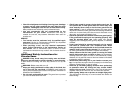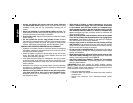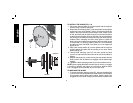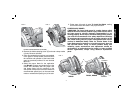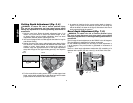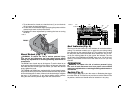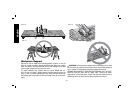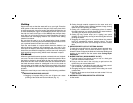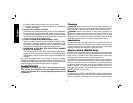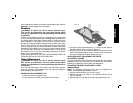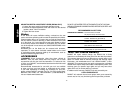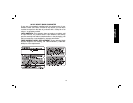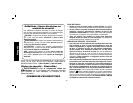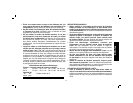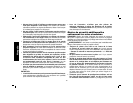
11
English
Cutting
Support the work so that the waste will be on your right. Place the
wider portion of the saw shoe on that part of the work piece which
is solidly supported, not on the section that will fall off when the cut
is made. As examples, Figure 12 illustrates the RIGHT way to cut off
the end of a board, and Figure 13 the WRONG way. Always clamp
work. Don’t try to hold short pieces by hand! Remember to support
cantilevered and overhanging material. Use caution when sawing
material from below.
Be sure that the saw is up to full speed before blade contacts
material to be cut. Starting the saw with blade against material to be
cut or pushed forward into kerf can result in kickback.
Push the saw forward at a speed which allows the blade to cut
without laboring. Hardness and toughness can vary even in the
same piece of material, and knotty or damp sections can put a heavy
load on the saw. When this happens, push the saw more slowly, but
hard enough to keep it working without much decrease in speed.
Kickback
When the saw blade becomes pinched or twisted in the cut, kickback
can occur. The saw is thrust rapidly back toward the operator. When
the blade is pinched or bound tightly by the kerf closing down, the
blade stalls and the motor reaction drives the unit backward. When
the blade becomes twisted or misaligned in the cut, the teeth at
the back edge of the blade can dig into the top surface of the wood
causing the blade to climb out of the kerf and jump back toward the
operator.
Kickback is more likely to occur when any of the following conditions
exist.
1. IMPROPER WORKPIECE SUPPORT
A. Sagging or improper lifting of the cut off piece can cause
pinching of the blade and lead to kickback (Fig. 11).
B. Cutting through material supported at the outer ends only
can cause kickback. As the material weakens it sags, closing
down the kerf and pinching the blade.
C. Cutting off a cantilevered or overhanging piece of material
from the bottom up in a vertical direction can cause kickback.
The falling cut off piece can pinch the blade.
D. Cutting off long narrow strips (as in ripping) can cause
kickback. The cut off strip can sag or twist closing the kerf and
pinching the blade.
E. Snagging the lower guard on a surface below the material
being cut momentarily reduces operator control. The saw
can lift partially out of the cut increasing the chance of blade
twist.
2. IMPROPER DEPTH OF CUT SETTING ON SAW
To make the most efficient cut, the blade should protrude only
far enough to expose 1/2 of a tooth as shown in figure 5. This
allows the shoe to support the blade and minimizes twisting and
pinching in the material. See the section titled Cutting Depth
Adjustment.
3. BLADE TWISTING (MISALIGNMENT IN CUT)
A. Pushing harder to cut through a knot, a nail, or a hard grain
area can cause the blade to twist.
B. Trying to turn the saw in the cut (trying to get back on the
marked line) can cause blade twist.
C. Over-reaching or operating the saw with poor body control
(out of balance), can result in twisting the blade.
D. Changing hand grip or body position while cutting can result
in blade twist.
E. Backing up the saw to clear blade can lead to twist if it is not
done carefully.
4. MATERIALS THAT REQUIRE EXTRA ATTENTION
A. Wet lumber



